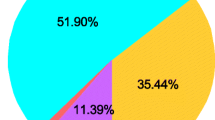Abstract
Objectives
(1) To investigate Egyptian obstetricians’ views towards cesarean delivery on maternal request, (2) to investigate Egyptian obstetricians’ views towards some of the “potentially neglected” or controversial obstetrical skills or maneuvers as external cephalic version (ECV), fetal scalp pH measurement or tubal ligation during CS and (3) to examine the effect of professional level on the above factors.
Study design
This is a descriptive study performed at the 8th annual Obstetrics and Gynecology conference of Suez Canal University held at Ismailia city in Egypt in June 2011 via a structured self administered questionnaire. Questionnaire was distributed to 223 conference attendants from the three professional levels (consultants, specialists and registrars) working at the two major institutions in Egypt: University and Ministry of Health. The structured questionnaire was based on informed opinion and professional guidelines. In total, 167 (75%) completed the questionnaire.
Results
Cesarean delivery on maternal request was accepted by 66% of the studied group and acceptance was significantly higher among consultants. There was no difference in all physicians’ practices of cesarean section in both private and public settings. Limited access to medical equipment such as cardiotocogram (CTG) was shown in consultant group reflecting improper private sector preparations. The study revealed that 59% of obstetricians accepted vaginal breech delivery, and only 14% would consider ECV. Fetal scalp pH taking in cases of abnormal CTG was accepted by only 16.3% and 49% rejected the practice of instrumental delivery. There were significant differences among the three professional and the two institutional groups regarding these attitudes. There were different views regarding tubal sterilization during CS.
Conclusions
Lack of knowledge, the need to improve some clinical skills and some professional attitudes may shed light on rising CS rates in Egypt.


Similar content being viewed by others
References
Allen VM, Baskett TF, O’Connell CM (2010) Contribution of select maternal groups to temporal trends in rates of caesarean section. J Obstet Gynaecol Can 32(7):633–641
Arikan D, Ozer A, Arikan A, Coskun A, Kiran H (2010) Turkisk obstetricians’ personal preference for mode of delivery and attitude towards cesarean delivery on maternal request. Arch Gynecol Obstet. doi:10.1007/s00404-010-1682-z
Bergholt T, Østerbrg B, Legarth J, Webster T (2004) Danish obstetricians’ personal preference and general attitude to elective cesarean section on maternal request: A national postal survey. Acta Obstet Gynecol Scand 83:262–266
Collaris R, Tan PC (2009) Oral nifedipine versus subcutaneous terbutaline tocolysis for external cephalic version: a double-blind randomized trial. BJOG 116(1):74–80 discussion 80–81
El-Zanaty F, Way AA (2009) Egypt Demographic and Health Survey. Cairo, Egypt: Ministry of Health and Population [Arab Republic of Egypt], National Population Council [Arab Republic of Egypt], El-Zanaty and Associates, and ORC Macro
Gabbe GS, Holzman GB (2001) Obstetricians’ choice of delivery. Lancet 357:722
Gedikbasi A, Akyol A, Bingol B, Cakmak D, Sergin A, Uncri R, Caylan Y (2010) Multiple repeated cesarean deliveries: operative complications in the fourth and fifth surgeries in urgent and elective cases. Taiwan J Obstet Gynecol 49(4):425–431
Gibbons L, Belizan J, Lauer J, Betran A, Meraldi M, Althabe F (2010) The global number and costs of additionally needed and unnecessary caesarean sections performed per year: over use as a Barrier to Universal Coverage. World Health report, Background paper, No 30. Retrieved from: http://www.who.int/entity/healthsystems/topics/financing/healthreport/30C-sectioncosts.pdf
Guise JM, Eden K, Emeis C, Denmen MA, Marshal N, Fur R, Janik R, Nygren P, Walker M, McDonagh M (2010) Vaginal birth after cesarean: new insights. Evid Rep Technol Assess 191:1–397
Jacquemyna Y, Ahankoura F, Martensb G (2003) Flemish obstetricians’ personal preference regarding mode of delivery and attitude towards caesarean section on demand. Eur J Obstet Gynecol Reprod Biol 111:164–166
Lataifeh I, Zayed F, Al-Kuran O, Al Mehaisen L, Kherisat W, Khadr Y (2009) Jordanian obstetricians’ personal preference regarding mode of delivery. Acta Obstet Gynecol Scand 88(6):733–736
Lawrence RE, Rasinski KA, Yoon JD, Curlin FA (2011) Factors influencing physicians’ advice about female sterilization in USA: a national survey. Hum Reprod 26(1):106–111
McCallum C (2005) Explaining caesarean section in Salvador da Bahia, Brazil. Sociol Health Illn 27(2):215–242
National Collaborating Centre for Women’s and Children’s Health (2004) Caesarean Section. National Evidence Based Guideline, London
Rauf B, Nisa M, Hassan L (2007) External cephalic version for breech presentation at term. J Coll physicians Surg Pak 17(9):550–553
Royal College of Obstetricians and Gynecologists (2004) The use of electronic fetal monitoring: the use and interpretation of cardiotocography in intrapartum fetal monitoring, vol 8, RCOG Press, London (Clinical guideline)
Ryan K, Schnatz P, Greene J, Curry S (2005) Change in caesarean section rate as a reflection of recent malpractices crisis. Conn Med 69:139–141
Spetz J, Smith MW, Ennis SF (2001) Physician incentives and the timing of cesarean sections: evidence from California. Med Care 39:536–550
Thomas J, Paranjohy S (2001) The National Sentinel Caesarean Section Audit Report. Royal College of obstetricians and gynecologists: clinical effectiveness support unit. RCOG press, London
Acknowledgments
This study was financially supported by Ford foundation through the pilot research component of the “PROGRAM OF TRAINING AND RESEARCH IN REPRODUCTIVE HEALTH” implemented by the Social Research Center of the American University in Cairo.
Conflict of interest
None.
Author information
Authors and Affiliations
Corresponding author
Additional information
An erratum to this article can be found online at http://dx.doi.org/10.1007/s00404-013-3014-6.
Rights and permissions
About this article
Cite this article
Shaaban, M.M., Ahmed, W.S., Khadr, Z. et al. Obstetricians’ perspective towards cesarean section delivery based on professional level: experience from Egypt. Arch Gynecol Obstet 286, 317–323 (2012). https://doi.org/10.1007/s00404-012-2277-7
Received:
Accepted:
Published:
Issue Date:
DOI: https://doi.org/10.1007/s00404-012-2277-7




